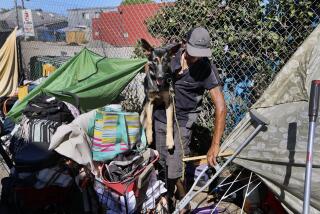Orange County moves to evict homeless from ‘skid row’ along Santa Ana River
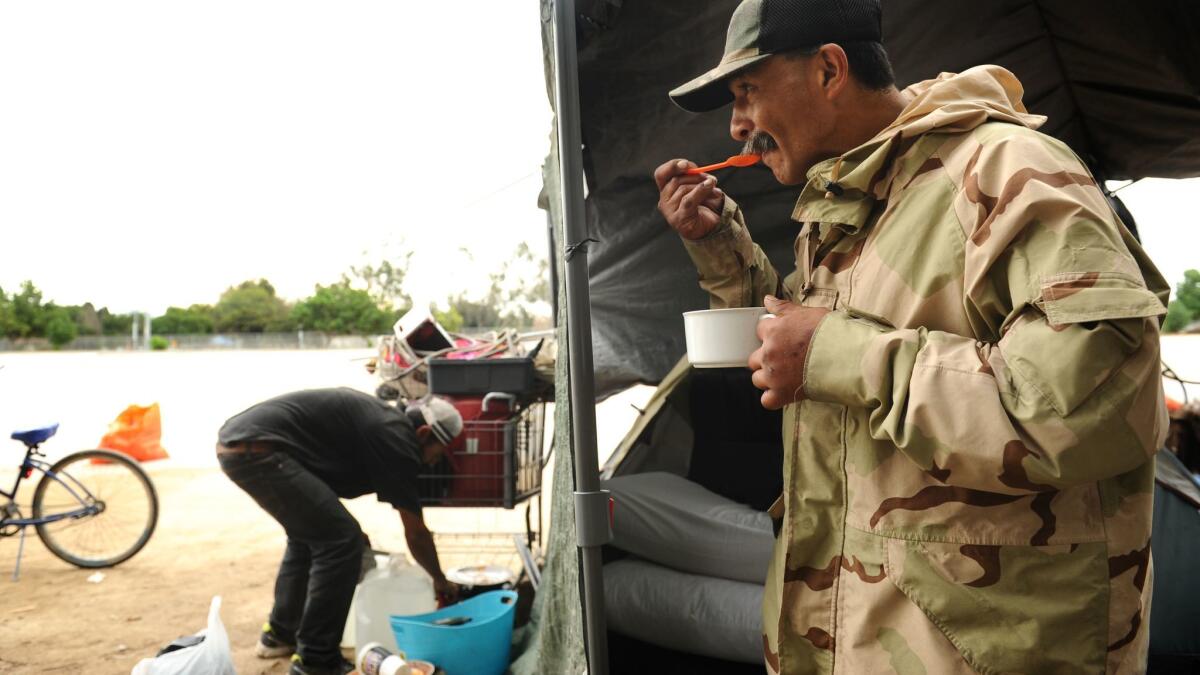
- Share via
The message on fliers stapled to wooden poles along the Santa Ana River trail in Orange County was clear to Sergio Guerra:
Move.
For the hundreds of homeless people who created a makeshift community of tents and encampments along the river’s concrete edges between Fountain Valley and Anaheim, it’s time to either pack up or face arrest.
“We can keep debating, but really, we have no one to turn to,” said Guerra, 44, who is among dozens of people living along the trail. “This happens to us over and over. I go from one city to this city and now I’ll have to find another city. We just have to take whatever stuff we can carry and move on.”
Over the last few years, Orange County has watched as the banks of the river have been transformed into what some officials describe as “skid row south,” a desperate and swelling community of homeless people.
The homeless problem has overwhelmed the affluent county, where growing communities of transients have sparked concern and at times conflict in numerous cities. Anaheim earlier this year removed bus benches in its Disneyland resort district after complaints about homeless people sleeping on them. The Orange County civic center in Santa Ana became another grim camp.
But the river has become the focus of the most tension, with residents saying the filthy conditions pose health and safety problems.
Clearing out the river trail coincides with a plan by county public works crews to start repairing flood control district property along the trail. Later this fall, workers will install gates at public entrances to the trail, locking them after closing hours, according to Carrie Braun, spokeswoman for Orange County.
It remains unclear where those kicked out of the homeless camps will go. Several surveys have found Orange County’s homeless population rising over the last few years, and officials have been trying to fashion a coordinated approach involving the county’s cities that takes into account the different causes of homelessness, including economic woes, a lack of healthcare and recent reforms in the criminal justice system.

Armories might provide temporary shelter for those displaced from the river trail. The National Guard armory in Santa Ana is open as a nightly sleeping area for the homeless during the winter. The Fullerton armory is expected to begin operating as a nighttime shelter Nov. 16.
County officials noted that Bridges at Kraemer Place in Anaheim and the Courtyard, which operates at the former Santa Ana Transit Terminal, are two homeless shelters that could provide assistance for people displaced from the river trail.
However, homeless advocate Lou Noble said many people who camp alongside the river will likely end up back on the city streets.
The standoff along the Santa Ana River shows the tension between Orange County’s suburban ideal and the grim reality of life without housing.
Residents who live near the river say the county’s clean up is long overdue.
“We’ve called everyone to get this taken care of -- those community resource officers, the sheriff’s homeless outreach team, code enforcement -- we’ve been fighting for the homeless removal since February,” said Sally Marsilio, whose condominium complex in Fountain Valley overlooks the trash-filled trail.
“Most people won’t even come out here because they’re so scared or so disgusted with the way things are,” added her friend Carol Martin as the pair walked their dogs a few hundred yards before returning to their homes. “We want our neighborhoods back. No one feels comfortable around here because the trail’s been taken over.”
Pamela Tansey, another Fountain Valley resident, expressed similar frustration. For years, Tansey referred to her condominium as the “condo on the prairie.”
She used to sit on her patio and watch people bike and jog along the Santa Ana River trail a few feet away. It was peaceful, she said — until the tents began to go up.
Homeless people started trickling into the area, near Harbor Boulevard and Edinger Avenue, about a year ago, setting up tents roughly 12 feet from her front door. In the last year, the number of homeless there has grown exponentially, she said.
People clean themselves in view of her windows, defecate into bags and pile trash along the trail, she said. She’s heard arguments in the tents and seen people wrapped in blankets shooting drugs.
In June, she said, a homeless man threw a can of soda and urine onto her patio.
“It’s horrific that the county has allowed this to happen,” Tansey said. “They need to realize that unless they get their arms around this, it’s only going to get worse.”
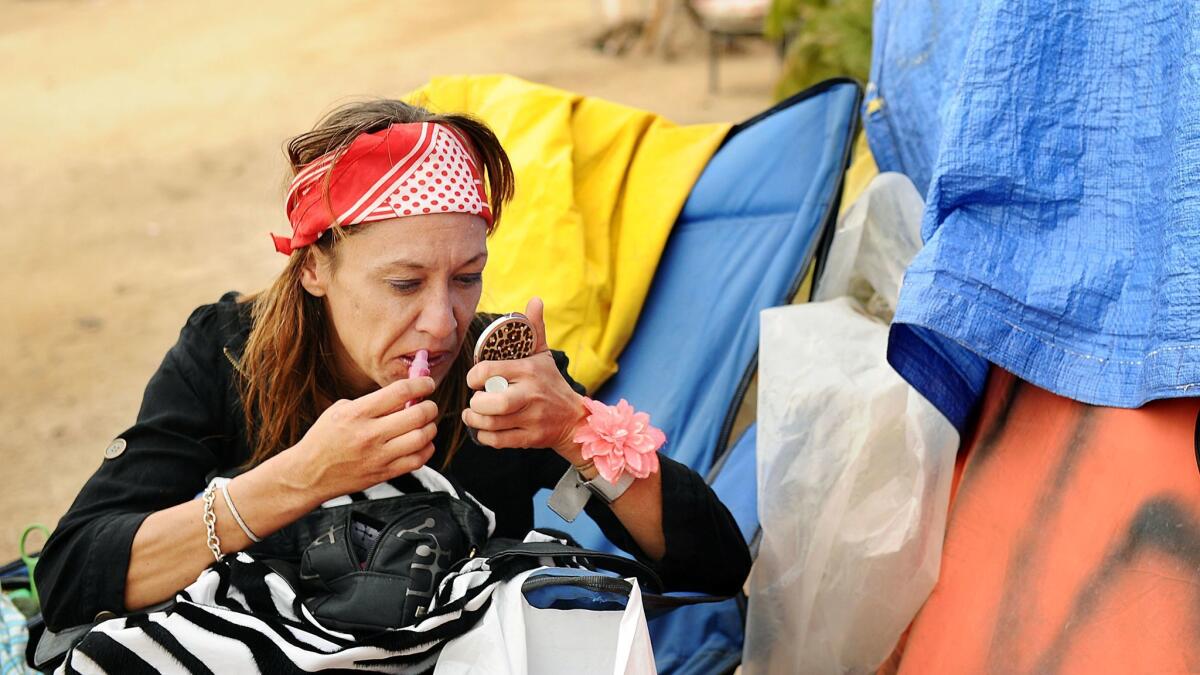
Eduardo Beltran, 23, said he has been homeless for almost five years after his drug habit forced his mother to kick him out of her house in Rancho Santa Margarita. He said he misses the teenage sister he left behind.
“I don’t want to be that kind of example to her,” Beltran said. “Recently, when I saw the [county’s posted] signs, I knew it’s time to leave … If it comes down to it, we’ll all leave, then return when the time is right.”
Outreach worker Donald Newsom, who helps homeless veterans at the 1736 Family Crisis Center in Garden Grove, said more social service workers or nonprofit teams need to visit the encampments “to see with their own eyes and hear about what’s going on.” He’s on site three or four times a month.
“I get it,” he said on a recent morning while passing out sweaters in the cold air. “Tenants in the area paying high rent don’t want to see this blight -- and while there are some shelters open in the county -- there are never enough.”
He said the county needs to tap its funds to come up with alternative solutions to the homeless problem — starting with providing vouchers for temporary housing.
“Rather than coming through here with a dump truck with county workers, why not spend county money that is available to give the needy temporary housing while they access services to get their lives in order?” Newsom said.
He said some people have lived on the streets so long “they’re numb to humanity. They don’t even know how to fill out documents.”
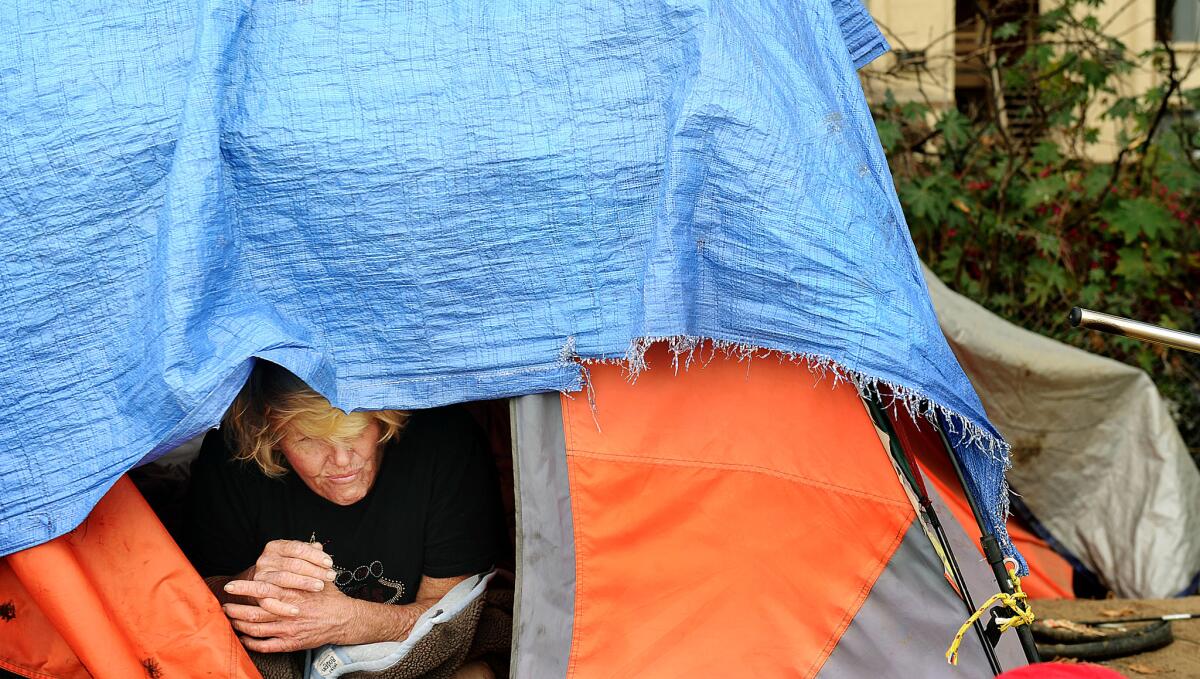
Nancy Gardner, 53, used to find refuge in her car. Now the Burbank native hunkers down in a cramped tent wrapped in blankets. She described the county’s plan to drive out the homeless “like they’re herding cattle to the slaughterhouse. They don’t see us as human. When you don’t bathe, you don’t cook, you don’t partake in normal activities, you’re not treated as normal.”
Gardner has not decided where to move. “We have rights, this is public land, but wherever we go, it’s always, ‘get out,’” she said.
Some of her homeless friends said they would welcome meeting county crews who might explain the eviction process and answer their questions. On Friday, officials began active enforcement of public hours along the trail from Anaheim to Fountain Valley.
People who are on the trail outside the posted hours of 7 a.m. to 6 p.m. are considered in violation of state trespassing laws and will be cited, officials said.
“I could move several streets down to MacArthur Boulevard, knowing we would have to leave again and again,” Guerra said. “You always have to think about the next spot.”
Noble, an Anaheim resident who has visited with homeless people in the Fountain Valley area, said the county hasn’t opened enough shelters to accommodate everyone who needs help.
Some homeless people say they are resistant to shelters because they would have to say goodbye to their pets.
Noble said county officials and homeless advocates need to work together to come up with a solution to get people off the streets permanently instead of shifting them around.
“People don’t really have a concept of who’s out there,” Noble said. “They think they’re all drug addicts and criminals. But we had a recession and a lot of people lost their homes. Where are these people supposed to go?”
But Orange County Supervisor Todd Spitzer called the county’s action a “progressive next step” in combating homelessness with compassion while ensuring the safety of nearby residents. Still, he was adamant in a statement issued last week about the need for the cleanup.
“People living in the encampments have every opportunity to accept a pathway out of homelessness,” Spitzer said. “There should be no excuse, and people not accepting assistance will have no choice but to leave the riverbed.”
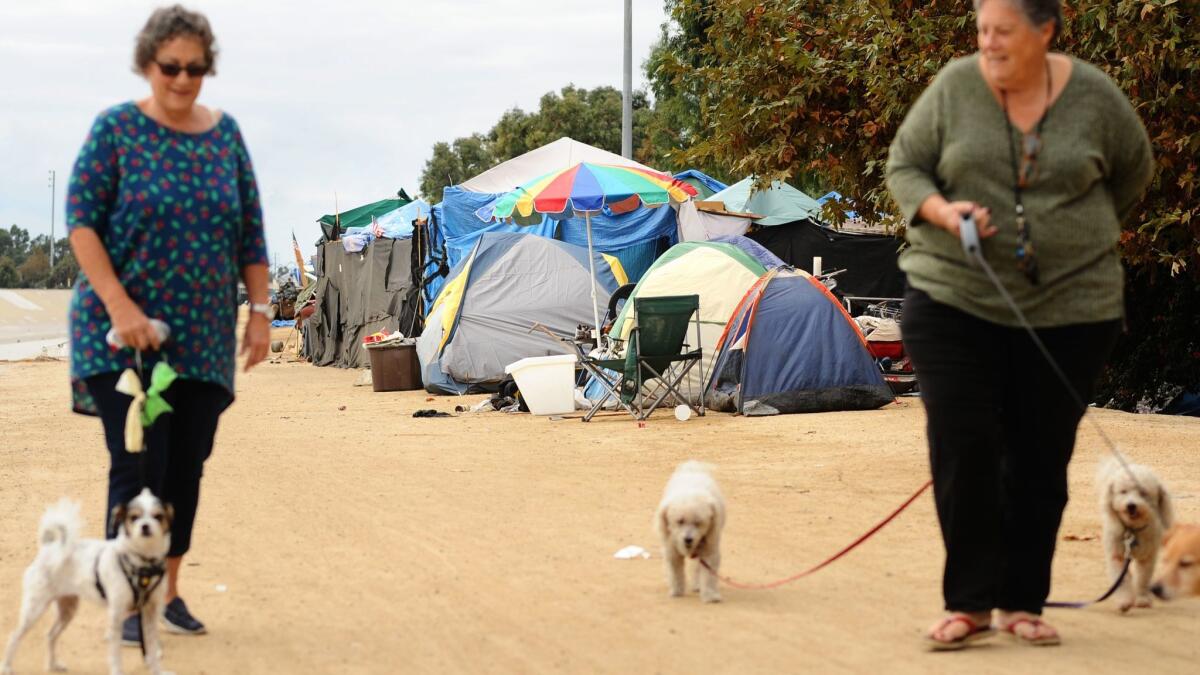
Twitter: @newsterrier
ALSO
San Diego focusing on homeless camps along river following hepatitis A outbreak
Steve Lopez: As renters struggle to pay the bills, landlords and speculators cash in
UPDATES:
1:10 p.m.: This article was updated with details about homeless shelters.
This article was originally published at 8:50 a.m.
More to Read
Sign up for Essential California
The most important California stories and recommendations in your inbox every morning.
You may occasionally receive promotional content from the Los Angeles Times.

